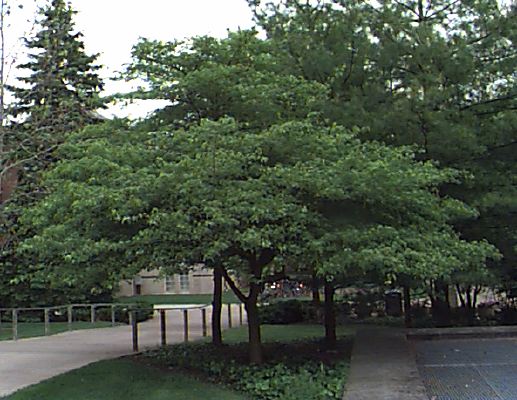Hawthorn Tree Biography
While it may be hard to believe that a tree can be a member of the rose family, the Hawthorn tree is exactly that. Considered invaluable as a hedgerow, this tree also has many culinary and medicinal properties.
Several varieties of the Hawthorn tree have developed over the years, but the original Hawthorn was historically and often still is used as a hedgerow. The name actually indicates this use, with its meaning being an old English term for "thorny hedge". A native of Africa, Europe and central Asia, this tree along with its hybrids have quickly gained popularity and are grown in most North American regions.
This tree is not finicky about its habitat; growing well in sunny conditions as well as partial shade and amenable to most soil types. Its 400 year life span only adds to the tree's remarkable characteristics. A height of 25 feet is normal, with an almost equal spread of up to 20 feet. Most of the species of the Hawthorn tree possess thorns, some reaching 5 inches in length. Its leaves differ depending on the variety.
Twice a year will find the Hawthorn tree in bloom, exhibiting tiny, white spherical buds at first; opening to reveal lovely white petals and a pink center. The back of the flower contains the beginning of a seed, which will develop into a bright red berry by the time fall rolls around.
One reason that the Hawthorn tree is well loved by landscapers is that it has multiple uses. The berries of the tree have long been used to improve the cardiovascular system. Controlling high blood pressure, helping blood flow in and out of the heart, dilating coronary arteries and assisting the heart in its use of essential minerals are examples of the medicinal properties of the Hawthorn berry. It is also packed full of antioxidants thought to be more potent than vitamins A, C and E.
Not to be overlooked are the culinary uses of the Hawthorn tree; once called the "bread and cheese" tree. Its leaves, when chewed, provide nourishment and re-energize the eater, taking away the rumbling in the tummy. The leaf buds can be cooked and either eaten plain or added to soups. The berries have long been used to make jellies and jams as they contain their own pectin. Flower buds are attractive as a garnish for foods and are edible as well.
Adding to the list of value is the wood of the Hawthorn tree. Trunk wood is used for carvings, and root wood is used in making boxes. When used as firewood, the Hawthorn tree wood burns at an extremely high heat; capable of melting pig iron.
Planting a Hawthorn tree can bring many benefits; medicinal, culinary and wood value, not to mention its natural beauty. There is little wonder it has endured through the centuries as a favored tree.
While it may be hard to believe that a tree can be a member of the rose family, the Hawthorn tree is exactly that. Considered invaluable as a hedgerow, this tree also has many culinary and medicinal properties.
Several varieties of the Hawthorn tree have developed over the years, but the original Hawthorn was historically and often still is used as a hedgerow. The name actually indicates this use, with its meaning being an old English term for "thorny hedge". A native of Africa, Europe and central Asia, this tree along with its hybrids have quickly gained popularity and are grown in most North American regions.
This tree is not finicky about its habitat; growing well in sunny conditions as well as partial shade and amenable to most soil types. Its 400 year life span only adds to the tree's remarkable characteristics. A height of 25 feet is normal, with an almost equal spread of up to 20 feet. Most of the species of the Hawthorn tree possess thorns, some reaching 5 inches in length. Its leaves differ depending on the variety.
Twice a year will find the Hawthorn tree in bloom, exhibiting tiny, white spherical buds at first; opening to reveal lovely white petals and a pink center. The back of the flower contains the beginning of a seed, which will develop into a bright red berry by the time fall rolls around.
One reason that the Hawthorn tree is well loved by landscapers is that it has multiple uses. The berries of the tree have long been used to improve the cardiovascular system. Controlling high blood pressure, helping blood flow in and out of the heart, dilating coronary arteries and assisting the heart in its use of essential minerals are examples of the medicinal properties of the Hawthorn berry. It is also packed full of antioxidants thought to be more potent than vitamins A, C and E.
Not to be overlooked are the culinary uses of the Hawthorn tree; once called the "bread and cheese" tree. Its leaves, when chewed, provide nourishment and re-energize the eater, taking away the rumbling in the tummy. The leaf buds can be cooked and either eaten plain or added to soups. The berries have long been used to make jellies and jams as they contain their own pectin. Flower buds are attractive as a garnish for foods and are edible as well.
Adding to the list of value is the wood of the Hawthorn tree. Trunk wood is used for carvings, and root wood is used in making boxes. When used as firewood, the Hawthorn tree wood burns at an extremely high heat; capable of melting pig iron.
Planting a Hawthorn tree can bring many benefits; medicinal, culinary and wood value, not to mention its natural beauty. There is little wonder it has endured through the centuries as a favored tree.
Hawthorn Tree
Hawthorn Tree
Hawthorn Tree
Hawthorn Tree
Hawthorn Tree
Hawthorn Tree
Hawthorn Tree
Hawthorn Tree
THE HAWTHORN TREE
THE HAWTHORN TREE - What To Look For - AV








No comments:
Post a Comment